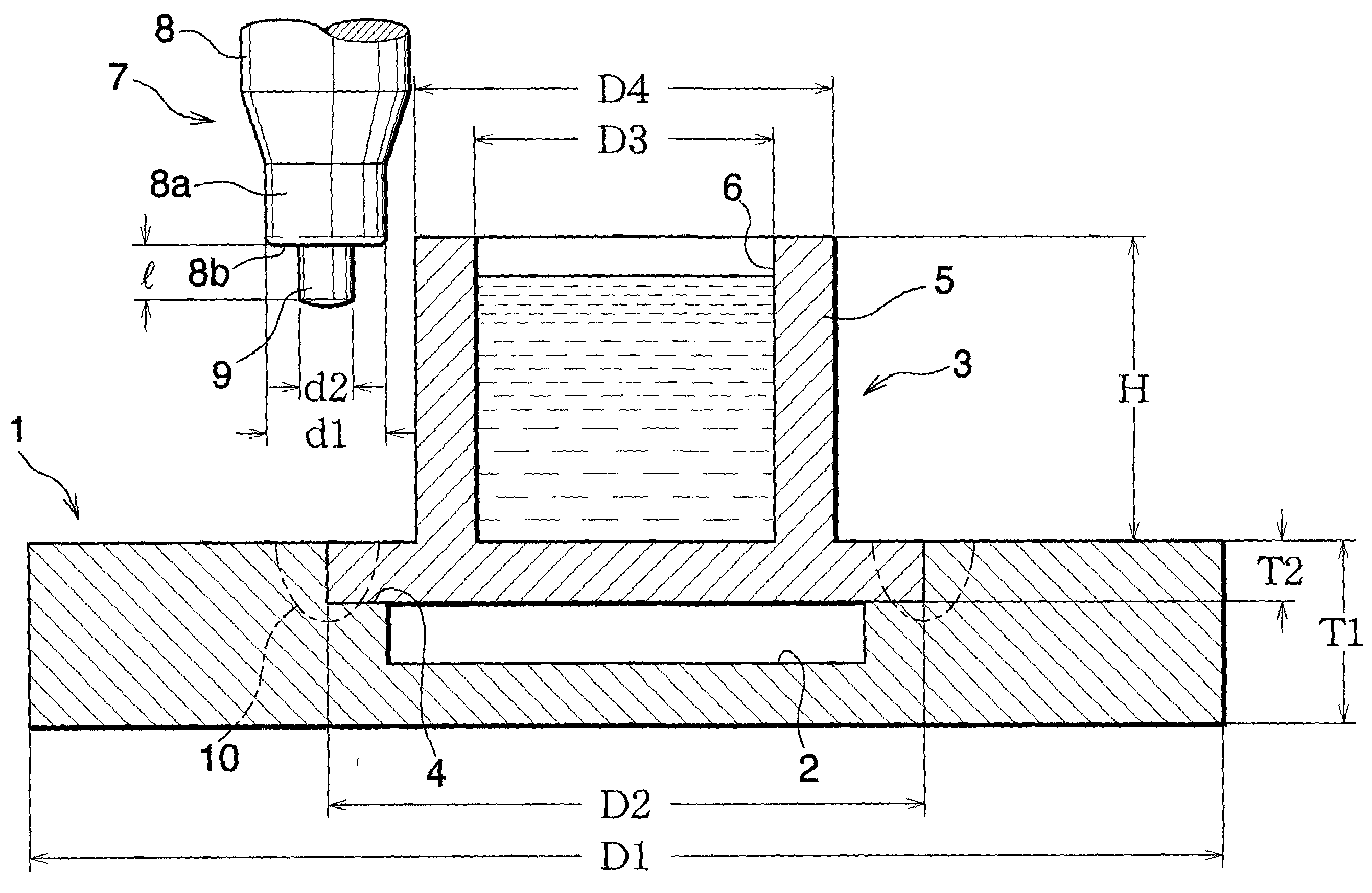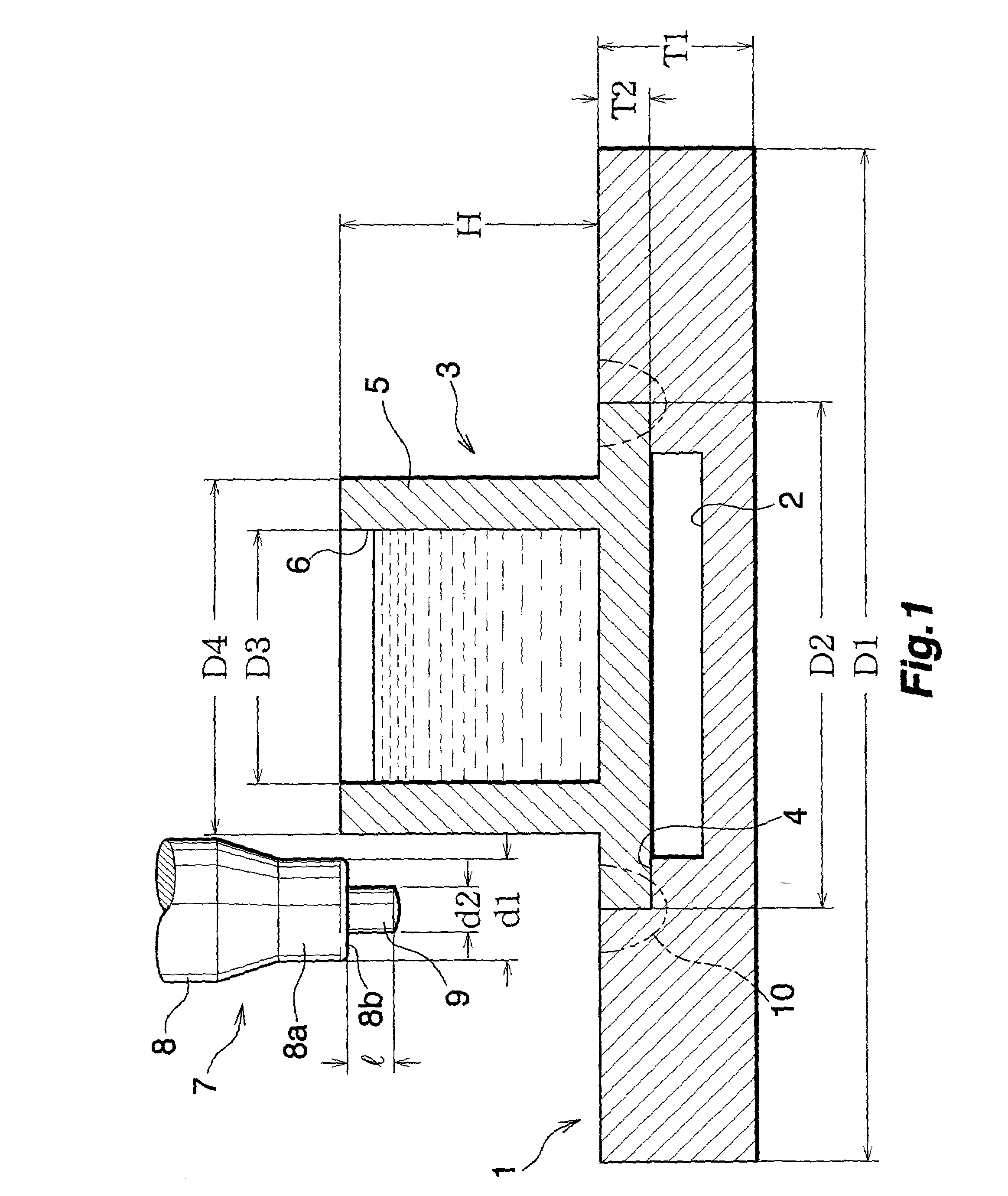Friction stirring-joining method and method of manufaturing hollow body
a friction stir and hollow body technology, applied in the direction of manufacturing tools, soldering devices, auxillary welding devices, etc., can solve the problems of deterioration in joining quality, increased apparatus cost, and troublesome associated setup work, so as to prevent the occurrence of defects in the joining end zone, the effect of variation in joining quality and high deformation resistan
- Summary
- Abstract
- Description
- Claims
- Application Information
AI Technical Summary
Benefits of technology
Problems solved by technology
Method used
Image
Examples
embodiment 1
[0027]The present embodiment is shown in FIGS. 1 to 3 and is a method of manufacturing a hollow body which consists of a base having a recess, and a cover fitted into the recess and closing the opening of the recess.
[0028]First, there are prepared a base 1 having a recess 2 whose inner peripheral surface is circular, and a disklike cover 3 which is fitted into the recess 2 and adapted to close the opening of the recess 2. A stepped portion 4 for supporting a circumferential portion of the cover 3 is formed on the inner circumferential surface of the recess 2 of the base 1 at a portion located on a side toward a bottom. The thickness of the cover 3 is smaller than the overall depth of the recess 2 and is equal to the depth of a portion of the recess 2 located above the stepped portion 4. The diameter of the cover 3 is equal to or slightly smaller than the inside diameter of the recess 2 as measured above the stepped portion 4. A cylindrical cooling-medium holder portion 5 whose inter...
experimental example
[0040]The base 1 and the cover 3 formed from JIS A2014-T6 were prepared. Outside diameter Dl of base 1: 200 mm; thickness T1 of base 1: 30 mm; inside diameter D2 of recess 2 as measured above stepped portion 4 (=diameter of cover 3): 100 mm; thickness T2 of cover 3 (=depth of recess 2 as measured above stepped portion 4): 10 mm; height H of holder portion 5: 50 mm; inside diameter D3 of holder portion 5: 50 mm; and outside diameter D4 of holder portion 5: 70 mm.
[0041]The prepared friction-stir-welding tool 7 had the following dimensions. Diameter dl of shoulder portion 8b as measured at end face of small-diameter portion 8a of rotor 8: 20 mm; diameter d2 of probe 9: 9 mm; and length l of probe 9: 10 mm.
[0042]Water of room temperature was placed to a depth of 30 mm in the cooling-medium accommodation recess 6 of the holder portion 5. Friction stir welding was carried out 360 degrees along the prospective joint region, with the probe rotational speed set to 500 rpm and the probe advan...
embodiment 2
[0046]The present embodiment is shown in FIG. 4 and is a method of manufacturing a hollow body which consists of a base having a recess, and a cover fitted into the recess and closing the opening of the recess.
[0047]In Embodiment 2, the holder portion 5 is not formed on the upper surface of the cover 3. When friction stir welding is to be performed, the base 1 is placed on a turntable 20, and the base 1 is fixed on the turntable 20 by means of a plurality of base clamp members 21 provided on the turntable 20. Furthermore, the cover 3 is fixed on the base 1 by means of a cover clamp member 22 provided separately from the turntable 20.
[0048]The cover clamp member 22 has a holder portion 23, which, in turn, has a closed-bottomed cooling-medium accommodation recess 24. In a state in which a liquid-phase cooling medium is placed in the cooling-medium accommodation recess 24 of the holder portion 23, the base 1 and the cover 3 undergo friction stir welding in a manner similar to that of E...
PUM
| Property | Measurement | Unit |
|---|---|---|
| Electrical resistance | aaaaa | aaaaa |
| Depth | aaaaa | aaaaa |
| Latent heat | aaaaa | aaaaa |
Abstract
Description
Claims
Application Information
 Login to View More
Login to View More - R&D
- Intellectual Property
- Life Sciences
- Materials
- Tech Scout
- Unparalleled Data Quality
- Higher Quality Content
- 60% Fewer Hallucinations
Browse by: Latest US Patents, China's latest patents, Technical Efficacy Thesaurus, Application Domain, Technology Topic, Popular Technical Reports.
© 2025 PatSnap. All rights reserved.Legal|Privacy policy|Modern Slavery Act Transparency Statement|Sitemap|About US| Contact US: help@patsnap.com



